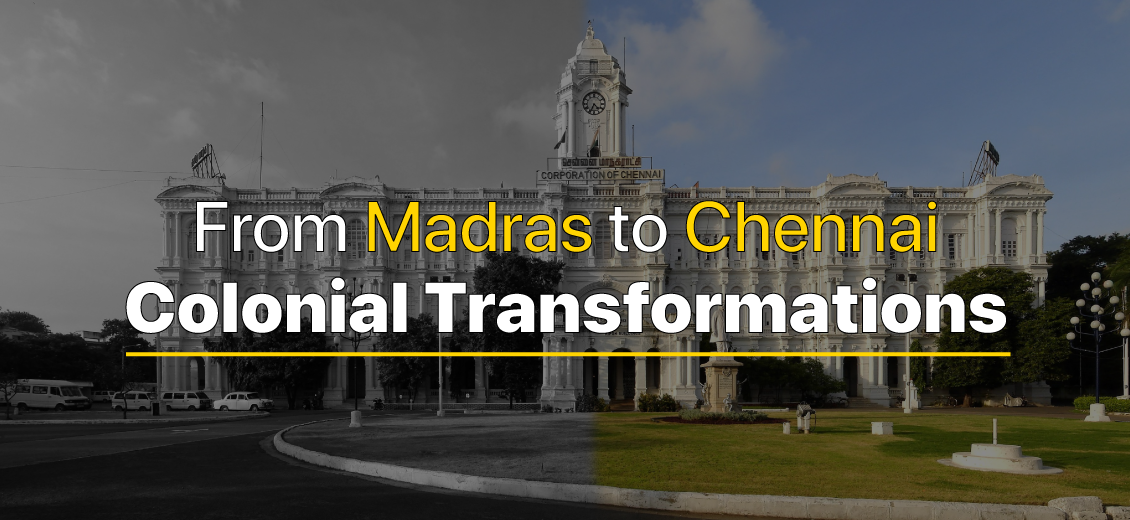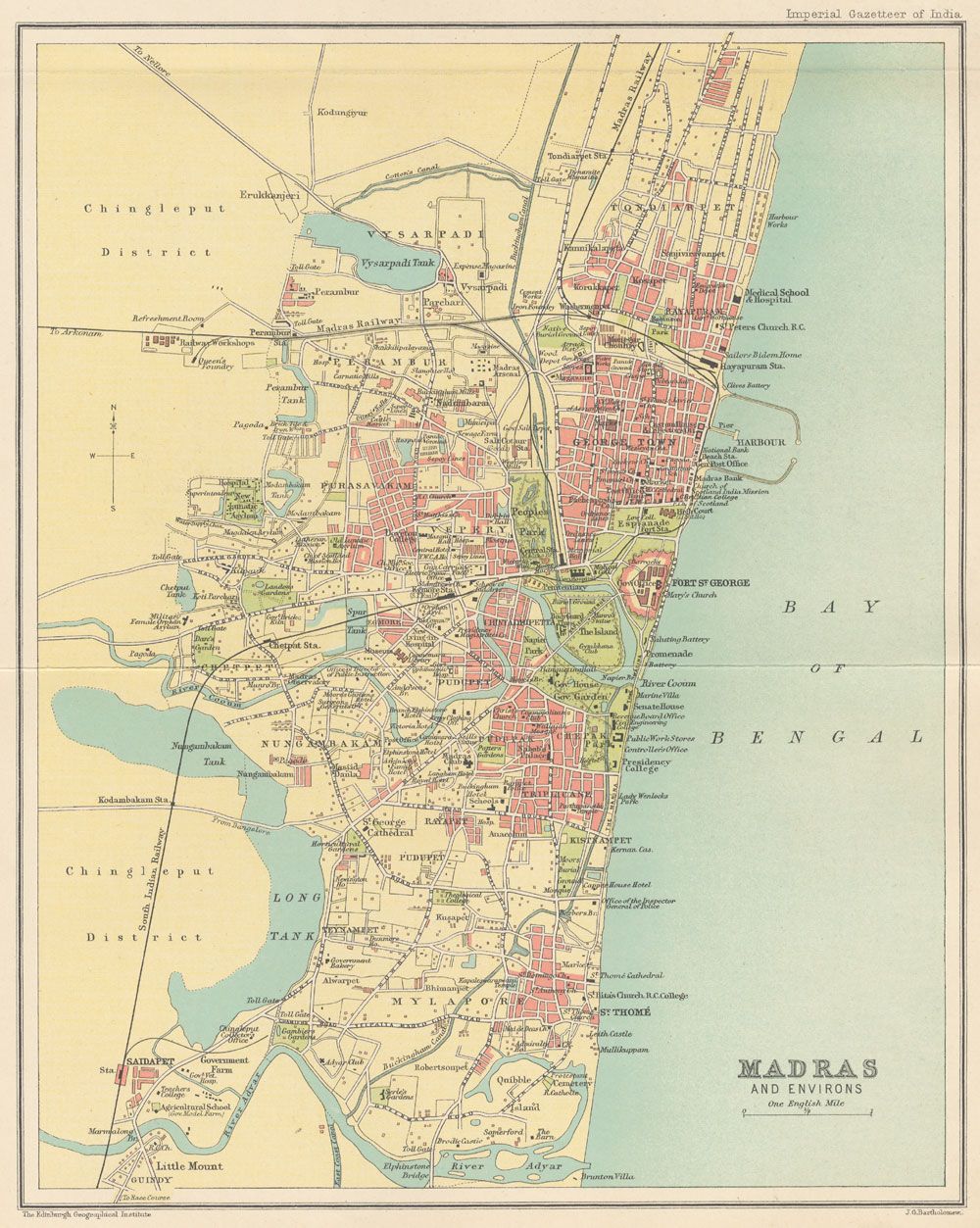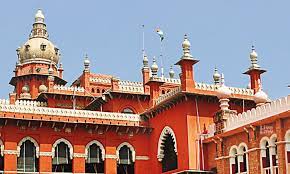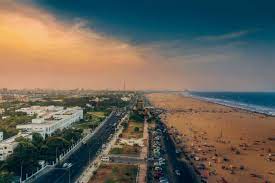From Madras to Chennai: Colonial Transformations
Blogs Home
- 24 Aug 2023

Introduction to Madras and Chennai
India’s thriving metropolis Chennai, the capital of Tamil Nadu, also known as the cultural capital of South India, has a rich and multifaceted history that spans centuries of cultural, economic, and social evolution. Formerly recognized as Madras, the city's transformation into Chennai reflects not only a change in nomenclature but also a profound shift in its identity and role in the Indian subcontinent. This journey from Madras to Chennai is a testament to the city's resilience, adaptability and enduring significance.
Brief History
Madras, or "Madras Patnam" as it was originally referred to, emerged as a modest fishing village along the Coromandel Coast. With its strategic coastal location and access to maritime trade routes, the village soon drew the attention of colonial powers, particularly the British East India Company (EIC).
The British colonial era witnessed the expansion and transformation of Madras. The establishment of Fort St. George marked the nucleus of British presence, leading to administrative, architectural, and economic developments that shaped the cityscape. Madras evolved into a significant port city, facilitating the exchange of goods and ideas between India and the rest of the world.
The transition from Madras to Chennai was more than just a change in name; it signified a shift in the city's identity and aspirations. Madras was rechristened in 1998 as Chennai (from Chennapatnam, which was a nearby town named by Damarla Venkatadri Nayaka in honour of his father, Damarla Chennappa Nayakudu) when some other Indian cities were also being renamed.
Geographical Location and Urban Importance
Chennai's coastal proximity and historical maritime importance have fuelled its status as a bustling port city, serving as a pivotal trading link between continents.
Old Map of Chennai
Source: Wikimedia Commons via Picryl.com
Its well-developed port infrastructure sustains modern economic dynamism, facilitating global trade and industrial growth. This strategic coastal location has nurtured a diverse cultural fabric and nurtured intellectual pursuits also, making Chennai a cosmopolitan hub. Leveraging its sea, land and air connectivity, Chennai has attracted international investments, corporations, and events, emerging as a contemporary global metropolis. From ancient maritime trade to its present-day global prominence, Chennai's geographical position remains a key driver of its historical, economic, and cultural journey as a major Indian urban centre.
Pre-Colonial Era
The origins of Madras Patnam within Tondaimandalam are steeped in historical significance, notably shaped by local rulers and dynasties. Chola’s influence began with Tondaiman Ilam Tiraiyan's rule in the 2nd century A.D., succeeding the Kurumbas, marking the start of a cultural blend and administrative structure. Subsequently, Chola leaders continued this cultural shaping through artistic patronage. Interruptions came from Andhra Satavahana incursions, leading to Pallava’s ascendancy in Kancheepuram, leaving architectural and administrative imprints. Pandya, Bahmini, and Vijayanagar’s influences further enriched Madras' cultural diversity and governance systems. These interactions created a cosmopolitan essence still evident in the city's architecture, religious practices, and societal norms.
Colonial Era and Establishment of British Madras
The Colonial Era marked a transformative phase in Madras' history with the arrival of the EIC in 1639. This pivotal moment saw the establishment of a strategic trading post, a catalyst that propelled Madras towards its evolution into a major colonial city. The trading post's impact was profound, extending beyond economic exchanges to influence administrative and governance frameworks that would mould the city's trajectory. The foundation laid by the EIC further solidified the city's significance, paving the way for British influence and control.
Numerous factors intertwined to shape Madras into a thriving colonial city. Its adjacency to fertile lands and abundant resources drove economic growth, attracting British investment in infrastructure and transportation networks. The establishment of Fort St. George in 1644 stood as a testament to the burgeoning British authority, serving as a hub for trade, security, and governance.
This transformation was intrinsically linked to the broader expansion of British dominance across India. Madras burgeoned into a focal point for trade, administration, and cultural exchange, underscoring its pivotal role within the British colonial framework.
Urban Planning and Architecture
During the colonial period, Madras underwent transformative urban planning and architectural developments influenced by British architecture. The establishment of Fort St. George in 1644 served as a foundation for organized urban growth. This layout provided a blueprint for the city's expansion, divided into functional zones for commerce, administration, and residences.
Architectural styles underwent a notable shift, with British architectural elements blending harmoniously with local influences. Landmarks like government buildings, churches, and commercial structures exhibited this fusion. The distinctive Indo-Saracenic style, characterized by the synthesis of Indian, European, and Islamic design elements, emerged prominently in structures such as the Madras High Court and Senate House.
Madras High Court
The implementation of structured urban planning was equally vital. Streets were laid out in a grid pattern to enhance accessibility and movement. Open green spaces and public infrastructure were thoughtfully incorporated, exemplified by the renowned Marina Beach. These colonial-era initiatives left an enduring impact on Madras' urban fabric, shaping its character, layout, and architectural identity.
Marina Beach
Economic Transformations
British trade policies were instrumental in transforming Madras' economy. The establishment of the EIC's trading post connected Madras to global markets, stimulating trade in textiles, spices, and agriculture. These policies fostered industrialization, with factories and industries emerging to meet international demand. However, the mercantilist approach often exploited local resources and altered trade dynamics, favouring British interests but it led to the growth of port-related industries and infrastructure, supported by Madras' strategic coastal location and natural harbour. Madras became a vital trade link, exporting goods and importing manufactured products. This economic growth influenced the city's industrial landscape and led to shifts in societal structures.
Social and Cultural Changes
During British rule in Madras, the caste system underwent significant changes influenced by both colonial policies and marginalized communities. This era saw a complex interplay of reinforcement and challenge to the rigid social hierarchy. The interplay of reinforcement and resistance laid the foundation for several social and political changes.
- Standardization and Legitimization: British colonialism standardized and legitimized the caste system through administrative reforms, integrating it into modern political identity.
- Escape from Caste Constraints: Colonial governance, rule of law, and education allowed marginalized groups to challenge caste barriers, seeking social mobility and freedom.
- British Non-Interference: British non-interference favoured Brahmins, upholding caste, while unintentionally promoting equality for lower castes.
- The emergence of Movements: Contradictory British policies led to movements among Dalits and minorities, utilizing media to challenge societal norms.
- Migration and Economic Freedom: Migration enabled to escape from caste oppression, leading to economic independence and freedom from agrarian systems.
- Political Representation and Identity: British governance politicized caste, leading to caste associations and extending caste identity into politics.
- Educational Empowerment: Separate schools for lower castes empowered marginalized communities, challenging traditional hierarchies.
- Dalit Press and Identity: Dalit journals empowered leaders to voice grievances and advocate social change. Dalit print culture embraced diverse perspectives and contributed to social reform movements.
- Impact on Vernacular Languages: British education introduced English as a symbol of prestige and upward mobility in Madras and eased communication with the colonial administration. The promotion of English affected local languages like Tamil, reducing their use in formal education.
Political Developments
The emergence of political consciousness and early nationalist movements in Madras played a crucial role in shaping India's struggle for independence from British colonial rule. During the late 19th and early 20th centuries, Madras witnessed the rise of various movements and leaders like C. Rajagopalachari and Subramania Bharati advocated for political rights, social reform, and Indian self-governance. These efforts marked a significant step towards the larger nationalist movement across the country.
Formation of Political Associations
- Indian National Congress (INC): The INC, established in 1885, had a presence in Madras. Leaders like Annie Besant and G. Subramania Iyer actively participated in the Congress sessions and propagated nationalist ideas.
- Justice Party: Founded in 1916, the Justice Party represented non-Brahmin communities and aimed to address their grievances and demand political representation.
Early Nationalist Leaders
- Annie Besant: An influential figure, Besant's home in Adyar became a centre for nationalist activities. She promoted Home Rule and emphasized Indian self-governance.
- Subramania Bharati: A renowned poet, Bharati used his literary work to inspire patriotism and promote social justice.
Social and Political Reforms
- Self-Respect Movement: Periyar E. V. Ramasamy led this movement to challenge Brahmin dominance, and caste hierarchy, and promote social equality.
- Non-Brahmin Movement: Focused on addressing caste-based inequalities, this movement demanded political representation for non-Brahmin communities.
Political Mobilization and Mass Movements
- Anti-Hindi Agitation: In the 1930s, Tamil leaders protested against the imposition of Hindi as a compulsory language in schools.
- Salt Satyagraha: Madras participated in the Salt Satyagraha, a nationwide movement against the salt tax imposed by the British.
Role of Press and Media
- Newspapers and journals played a vital role in disseminating nationalist ideas and mobilizing public opinion.
- "Swadesamitran" and "Justice" were prominent newspapers that advocated for self-governance and social reforms.
These early nationalist movements in Madras contributed to the larger Indian freedom struggle. They laid the foundation for the Dravidian movement and continued to influence Tamil Nadu's socio-political landscape.
Post-Independence Chennai
As India gained independence, Madras underwent a significant transformation, culminating in its renaming as Chennai. It reflected a broader trend of Indian cities reclaiming indigenous names after colonial rule to assert cultural pride shed colonial associations and promote local heritage.
After independence, Chennai experienced significant urban development but also encountered various challenges. Urbanization brought modernization, industrialization, and improved infrastructure, transforming the city into a major economic and cultural hub. However, it also gave rise to several issues which still persist.
Infrastructural Issues
- Chennai witnessed an expansion of roads, railways, airports, and port facilities, enhancing connectivity and trade but at the same time, increased vehicles caused traffic congestion and pollution, demanding better transportation management.
- Ageing and inadequate infrastructure struggled to meet demands, impacting water supply, sewage, and waste management.
- Poor drainage exacerbated flooding during monsoons, causing damage and disrupting life.
Urban Challenges
- Rapid urbanization led to overpopulation, straining resources, housing, and public services.
- Inadequate housing and migration resulted in slums and unauthorized settlements.
- Urban challenges included sanitation, waste disposal, and access to healthcare, affecting public health.
- Urbanization led to deforestation, pollution, and water scarcity, necessitating sustainable development.
- Efficient urban planning and governance were crucial to address these challenges effectively.
Sociocultural Disparities
- Urbanization accentuated wealth disparities, with unequal access to resources and services.
- Modernization challenged traditional cultural aspects, raising concerns about preserving heritage.
Chennai stands today as a thriving metropolis, a testament to its enduring resilience and adaptability. While celebrating its historical legacy, it grapples with modern-day challenges such as urban sprawl, infrastructure development, water scarcity, climate change, effective governance, and now the digital divide.
Relevance and Importance of Studying Colonial Transformation
Studying the colonial transformations of Madras/Chennai is paramount for understanding India's intricate historical tapestry. The city's journey encapsulates the complexities of colonialism, socio-cultural shifts, economic dynamism, and political evolution. Chennai's role as a significant metropolitan centre continues to shape India's economic, political, and cultural landscapes, underscoring its enduring relevance in a rapidly changing world.
Sources:
- https://www.thehindu.com/features/kids/story-of-madras/article5041625.ece
- https://chennai.nic.in/history/
- https://chennaicorporation.gov.in/gcc/about-GCC/about-chennai/origin-and-growth/
- https://www.cmdachennai.gov.in/pdfs/seminar_heritage_buildings/Indo_Saracenic_Architecture_in_Chennai.pdf
- https://www.epw.in/journal/2020/42/insight/dalit-journals-colonial-madras-1869%E2%80%931943.html
- https://www.madrasmusings.com/vol-29-no-22/rise-of-early-tamil-newspapers-through-the-swadesamitran-prism/
- https://www.stockholmresilience.org/research/research-news/2017-05-10-swallowing-valuable-land.html
- https://www.outlookindia.com/magazine/national/anti-hindi-movement-the-grassroots-struggle-for-tamil-pride-magazine-193541
- https://www.thehindu.com/features/friday-review/history-and-culture/madras-and-the-freedom-movement/article5052377.ece
- https://www.thehindu.com/society/The-forgotten-founder/article16789476.ece
Priyanka Todariya

Priyanka Todariya is a Public Administration post-graduate and an experienced communications professional who has extensively worked for several government entities like Ministry of Jal Shakti, Ministry of Skill Development and Entrepreneurship, National Skill Development Corporation (NSDC) and state governments like Uttar Pradesh and Gujarat.
Blogs Home






